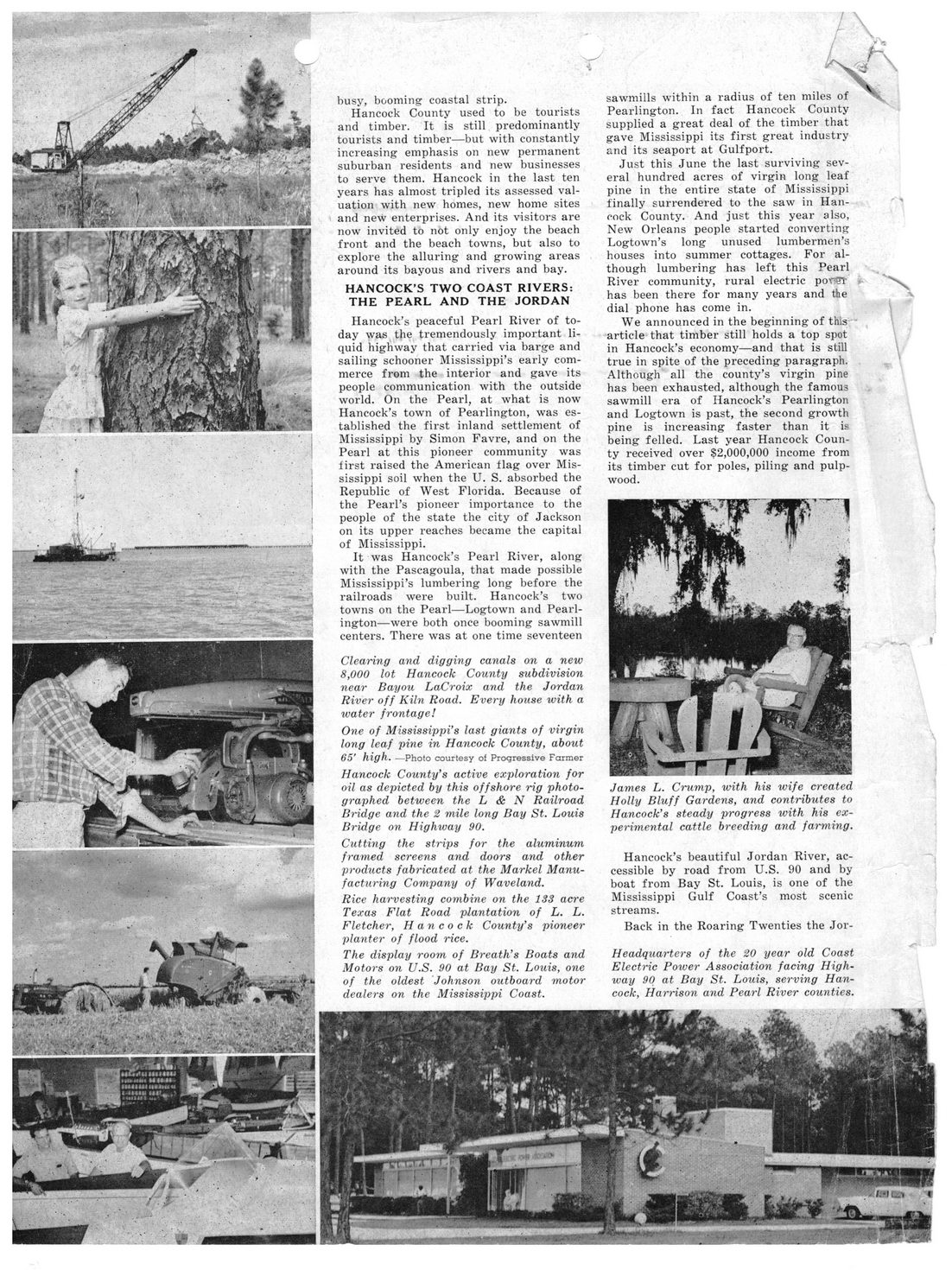This text was obtained via automated optical character recognition.
It has not been edited and may therefore contain several errors.
busy, booming coastal strip. Hancock County used to be tourists and timber. It is still predominantly tourists and timber—but with constantly increasing emphasis on new permanent suburban residents and new businesses to serve them. Hancock in the last ten years has almost tripled its assessed valuation with new homes, new home sites and new enterprises. And its visitors are now invited to not only enjoy the beach front and the beach towns, but also to explore the alluring and growing areas around its bayous and rivers and bay. HANCOCK’S TWO COAST RIVERS: THE PEARL AND THE JORDAN Hancock’s peaceful Pearl River of today was the tremendously important liquid highway that carried via barge and sailing schooner Mississippi’s early commerce from the interior and gave its people communication with the outside world. On the Pearl, at what is now Hancock’s town of Pearlington, was established the first inland settlement of Mississippi by Simon Favre, and on the Pearl at this pioneer community was lirst raised the American flag over Mississippi soil when the U. S. absorbed the Republic of West Florida. Because of the Pearl’s pioneer importance to the people of the state the city of Jackson on its upper reaches became the capital of Mississippi. It was Hancock’s Pearl River, along with the Pascagoula, that made possible Mississippi’s lumbering long before the railroads were built. Hancock’s two towns on the Pearl—Logtown and Pearlington—were both once booming sawmill centers. There was at one time seventeen Clearing and digging canals on a new 8,000 lot Hancock County subdivision near Bayou LaCroix and the Jordan River off Kiln Road. Every house with, a water frontage! One of Mississippi’s last giants of virgin long leaf pine in Hancock County, about 65' high. —Photo courtesy of Progressive Farmer Hancock County’s active exploration for oil as depicted by this offshore rig photographed between the L&N Railroad Bridge and the 2 mile long Bay St. Louis Bridge on Highway 90. Cutting the strips for the aluminum framed screens and doors and other products fabricated at the Markel Manufacturing Company of Waveland. Rice harvesting combine on the 133 acre Texas Flat Road plantation of L. L. Fletcher, Hancock County’s pioneer planter of flood rice. The display room of Breath’s Boats and Motors on U.S. 90 at Bay St. Louis, one of the oldest Johnson outboard motor dealers on the Mississippi Coast. sawmills within a radius of ten miles of Pearlington. In fact Hancock County supplied a great deal of the timber that gave Mississippi its first great industry and its seaport at Gulfport. Just this June the last surviving several hundred acres of virgin long leaf pine in the entire state of Mississippi finally surrendered to the saw in Hancock County. And just this year also, New Orleans people started converting Logtown’s long unused lumbermen’s houses into summer cottages. For although lumbering has left this Pearl River community, rural electric ponsr has been there for many years and the dial phone has come in. We announced in the beginning of this-' article that timber still holds a top spot in Hancock’s economy—and that is still true in spite of the preceding paragraph. Although all the county’s virgin pine has been exhausted, although the famou3 sawmill era of Hancock’s Pearlington and Logtown is past, the second growth pine is increasing faster than it is being felled. Last year Hancock County received over $2,000,000 income from its timber cut for poles, piling and pulp-wood. James L. Crump, with his wife created Holly Bluff Gardens, and contributes to Hancock’s steady progress with his experimental cattle breeding and farming. Hancock’s beautiful Jordan River, accessible by road from U.S. 90 and by boat from Bay St. Louis, is one of the Mississippi Gulf Coast’s most scenic streams. Back in the Roaring Twenties the Jor- Headquarters of the 20 year old Coast Electric Power Association facing Highway 90 at Bay St. Louis, serving Hancock, Harrison and Pearl River counties.

BSL 1950 To 1969 Hancock-County-Western-Gateway-(02)